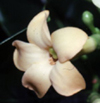SEARCH the
Gentian Research Network
and Rutgers University:
GENTIANS
Classification (newest)
List of genera
List by tribe
Gentian characteristics
Gentianales
RESEARCH
Research projects
People, addresses
Literature, publications
Links
Add info to
this site
TOPICS
Anatomy
Common names
Ecology - Natural history
GEOGRAPHY
Floras
Latin America
North America
TRIBES
Saccifolieae
_____________________
Information in other languages:
_____________________
This page
is maintained
by Dr.
Lena
Struwe
(e-mail),
and hosted by
Rutgers University, USA
updated: 01/19/11
|
Gentian gardening - a short introduction to gentian horticulture |
 |
||||||||||||||||||||||||||||||||||||
|
Many gentians can be cultivated in gardens, both in tropical and temperate regions. In the temperate areas, gentians are mostly known as excellent rock garden plants. The species that are mostly cultivated are from the genus Gentiana (photo).
The North American prairie gentian/lisianthus (Eustoma - photo) is common as a potted plant that rarely last long, in gardens in warmer temperate or subtropical climates, or as cut flowers. Eustoma is called lisianthus in English, but is not closely related to the Caribbean and Central American gentian genus with the Latin name Lisianthius.
The Persian violet (Exacum - photo) has small purple, blue, or white flowers and is also common as a potted plant. Most common in tropical Asia and the Pacific is Fagraea (photo), a shrub or tree with fragrant white flowers. For more information on how gentians are used worldwide for different purposes, see ethnobotany.
But gentians are not necessarily easy to grow. Here are some advice: - gentians dont like to be disturbed (dont touch their roots) - lots of light - never let soil dry out: well-drained soil - try to mimic natural conditions for each species - sometimes germination can take years, it is easier to start with plants. - some species need chilling after they have been sown. - some species have mycorrhizae (they live in symbiosis with fungi)
Contact a rock garden society or get your hands on a gentian garden book for more advice on how to grow gentians (see below). DO NOT DIG UP WILD GENTIANS. They will rarely survive the transplantation and many are close to extinction, so get these pretty plants from nurseries or grow them from seeds. Seeds are often available from nurseries, societies, and even on eBay. Tissue cultured gentians come from clones and is a good alternative to wild collected plants.
Some pests, insects, and viruses that live on and attack gentians.
Gentians that are commonly cultivated in temperate gardens (hardy)
Gentians that are commonly cultivated in semi-tropical/tropical gardens or indoors (not hardy)
Bartlett, M. 1975. Gentians. Blandford Press, Ltd, Poole, United Kingdom. (cultivation of gentians) Berry, G. H. 1930s. Gentians in the garden. Farrar, Straus, & Young. Inc., New York, NY. (cultivation of gentians) Halda, J. J. 1996. The genus Gentiana. SEN, Dobrι. (pretty pictures and descriptions of many cultivated species) Ho, T.-N. & S.-W. Liu. 2001. A worldwide monograph of Gentiana. Science Press, Beijing. (taxonomy of gentians) Klaber, D. 1964. Gentians for your garden. M. Barrows & Co., Inc., New York, NY. (cultivation of gentians) Kφhlein, F. 1991. Gentians. Timber Press, Portland. (cultivation of gentians) (link) Wilkie, D. 1950. Gentians. Country Life Ltd, London. (cultivation of gentians)
Links to web sites and companies working with gentian gardening: Tissue culture of gentians (GRN web page) Alpine Garden Society, United Kingdom Botany.com (garden plant information, encyclopedia of common and Latin names, terminology) Hannelotte Kindlund, Sweden: how to grow gentians hort.net: Gentianaceae (images) Rock Garden Plant Database by Pavel Slabύ: Gentianaceae (descriptions, distribution, cultivation, propagation, photos) Borghese Gardening: Native plant seeds from US Xplant Laboratory: Tissue cultured gentians (see photos)
© Lena Struwe, 2003-2006 |
|||||||||||||||||||||||||||||||||||||





